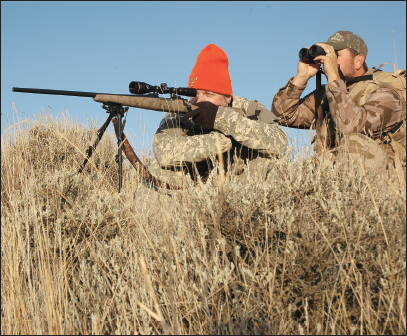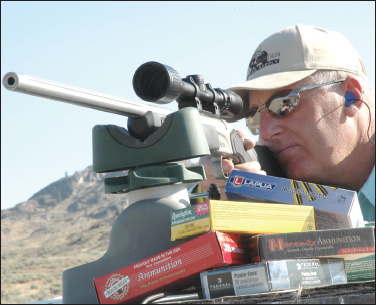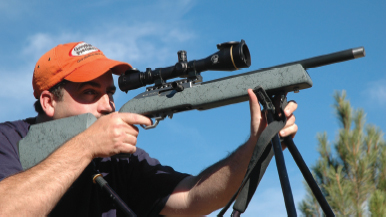21. Figuring bullet flight
Even a fast automobile moves at a glacial pace, compared to a bullet. A sedan traveling 60 miles per hour covers 88 feet per second. Relatively sedate rifle loads cough bullets out at 2,500 fps.
A bullet decelerates as soon as it escapes the thrust of powder gas—that is, as soon as it exits the barrel. Air resistance and friction, plus the turbulence set up in flight, act like brakes. All the while, gravity pulls the bullet toward earth at the accelerating rate of 32 fps. Energy measured in foot-pounds is a function of bullet weight and the square of bullet velocity, so as the bullet slows, it loses its authority.
Most bullets travel too fast for us to see. So measuring their speed and tracing their path proved difficult for the first shooters. Then in 1537 a brilliant Italian scientist named Trataglia wrote a ballistics book. He postulated that bullets traveled in arcs, a radical idea when many people assumed bullets flew straight until spent, then fell abruptly to earth. Trataglia also experimented to determine the launch angle that would give a bullet its greatest range, and found this angle to be near 45 degrees. This is much steeper than the angle you’d choose to give a .30-06 bullet its greatest reach. But Trataglia’s conclusion was valid. At the very low velocities of his day, gravity has a far greater effect than air resistance on a bullet’s flight. Modern high-speed bullets, in contrast, are influenced less by gravity than by drag.

Rich Folsland readies for a long shot, bipod supporting his rifle. He nailed a very fine pronghorn!
A century later, in a trajectory study for the Venice arsenal, Galileo dropped cannon balls from the Leaning Tower of Pisa. He concluded that because the acceleration of gravity was constant, a bullet’s path must be parabolic. Galileo affirmed Trataglia’s finding of 45 degrees as the launch angle for maximum range. His experiments did not take drag into account because, again, in those days projectiles were very heavy, very slow. Compared to the acceleration of gravity, drag on a cannonball dropped from a window was inconsequential!
Another century passed before Englishman Benjamin Robins devised a ballistic pendulum. Firing a bullet of known weight into its heavy wooden bob, also precisely weighed, Robins calculated velocity by measuring the pendulum’s swing. His colleagues in the 1740s could hardly believe that a 75-caliber musket ball traveled at the blinding speed of 1,500 fps! Low readings farther from the bob indicated that drag on the ball was 85 times as strong as the force of gravity! That too seemed incredible. Measurements of drag would eventually bear out the results of Robins’ work, but they would have to wait many decades, for the development of the chronograph.
Robins was in good company. Sir Isaac Newton, who had died only 15 years before he began his pendulum experiments, had come up with important observations in the fields of physics and mathematics. One was the universal law of gravitation, which declares that the force of gravity varies with altitude. Sir Isaac’s fundamental laws of mechanics, and his development of calculus (Leibnitz worked on calculus in Germany at the same time), were crucial pieces in the complex puzzle of ballistics. Newton showed that drag increases with the density of air and the cross-sectional area of the projectile. He also demonstrated a relationship between drag and the square of the projectile’s speed. Because he had no way to measure the speed of musket balls, he could not know that drag increases dramatically when projectiles approach the speed of sound (1,120 fps).

Sam Shaw wrings out a CVA Apex rifle at the bench, testing several types of .308 ammunition.
Late in the nineteenth century, scientists hit upon the idea of a “standard” bullet, of certain dimensions and weight and with specific flight characteristics. Deriving ballistic coefficient, or C, was a logical next step. Ballisticians the world over were soon making drag calculations. The best-known were by Krupp in Germany and the Gavre Commission in France. The Krupp standard bullet was a flat-based conical, 3-calibers long, with a 2-caliber ogive. Shortly after the Krupp data was published, a Russian colonel named Mayevski developed a mathematical model that showed the drag deceleration of this bullet. A formula by Russian Colonel Mayevski became the basis for tables by US Army Colonel James Ingalls. Published in 1893 and revised in 1917, the Ingalls tables feature a standard Krupp bullet, similar in form to modern hunting bullets. While matching bullets by shape and weight provides serviceable C values, velocity affects ballistic coefficient too. Because drag increases with speed, you can’t expect shooting tests of the same bullet at different speeds to yield the same C. For the same reason, tests of different bullets at different speeds are invalid for determining C.
“It’s common to see differences of 10 percent between calculated Cs and those determined by our firing tests,” say technical experts at Sierra Bullets. Lacking facilities to test C by shooting, you can get a usable value with this formula: C = w/id2, where w is bullet weight in pounds, d is bullet diameter in inches and i is the form factor. C includes sectional density and the bullet’s weight divided by the square of its diameter (w/d2). Form factor, i, has to do with the bullet’s profile. Long, pointed bullets with tapered heels have high sectional densities and high Cs. Blunt bullets of the same weight have high sectional densities, but less aerodynamic form, which means lower Cs and steeper deceleration rates.
The most streamlined match and VLD (very low drag) bullets have C values approaching .600. Magazine length and seating depth can make use of VLD bullets impractical in hunting rifles that accept bullets with C values of .400. Changes in drag, which most directly affects bullet drop, do not correspond linearly to changes in C. A bullet with a C of .600 and a starting velocity of 3,000 fps falls about 58 inches at 500 yards. A bullet with a C of .400 sags 65 inches—not much more, given the 33-percent change in C. Remaining energy more closely reflects changes in point of impact than differences in C: here, 2,256 ft-lbs for the first bullet, 1,929 for the second. At distance, high C helps you more than does a fast launch. A faster bullet has a higher deceleration rate and has shed its advantage at long range, where the high C exerts proportionately more influence.

Factory charts are sometimes inaccurate. A chronograph (here Pact screens) reveal true speed.

Don Ward fires a custom 10/22 Ruger. A .22 Long Rifle bullet hits top speed in a 16 inch barrel.
If you reduce velocity by 500 fps, to 2,500 fps, both bullets drop much farther over 500 yards. The bullet with a C of .600 drops 85 inches—27 inches more than it did at a starting velocity of 3,000 fps. The bullet with a C of .400 drops 96 inches—31 inches more than it did with the faster start. Remaining energy: 1,835 and 1,551 ft-lbs. It seems that a reduction in velocity only half as great (by percentage) as a reduction in ballistic coefficient can have a greater effect on bullet drop and remaining energy at distance.
A couple of other things to remember: A change in C has a larger effect on remaining velocities at high muzzle velocities than at low ones, because as bullets speed up, drag increases as a percentage of the forces impeding bullet flight. Secondly, a change in C has a greater effect on drop at lower velocities than at high ones, because at low speeds, gravity takes a more active hand than drag in depressing a bullet’s arc.
Ballistic coefficients change markedly near the speed of sound.
The retarding effect of air friction is enormous. In a vacuum, a 150-grain .30-06 bullet fired at 2,700 fps at a 45-degree upward angle can fly 43 miles! The same bullet fired at the same speed and angle through our atmosphere falls to earth just two miles out, victim of air resistance 56 times as strong as gravity! The higher the velocity, the stronger the drag. Drag comprises several factors. Their sum depends on bullet speed, weight and profile, as well as axial spin and atmospheric conditions. Jacket texture affects drag via “skin friction.” A sharp nose reduces “pressure drag,” but so does super-sonic speed. “Wave drag” results from the shock of a bullet traveling above the speed of sound. “Base drag” comes in the bullet’s wake; a tapered heel or boat-tail bullet minimizes base drag at distance.

Wayne fired this 1 inch five-shot group prone, the sling taut on a Remington 700 in .22-250.
Table of contents
- Title Page
- Dedication
- Copyright
- Acknowledgments
- Foreword
- CONTENTS
- INTRODUCTION
- SECTION I: BALLISTICS IN HISTORY
- SECTION II: THE MUSCLE BEHIND THE SHOT
- SECTION III: BULLETS—THE INSIDE STORY
- SECTION IV: SPEED, ENERGY, AND ARC
- SECTION V : PUTTING BALLISTICS TO WORK
- SECTION VI: FOR LONGER REACH
- BALLISTICS TABLES FOR MODERN SPORTING RIFLES
- GLOSSARY